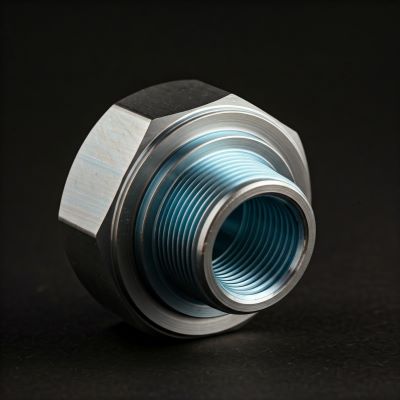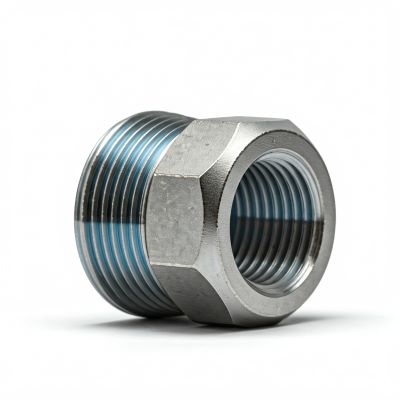Understanding the nuances of thread types is crucial in various industries, from manufacturing and construction to plumbing and automotive. Two of the most common thread standards are NPSM and NPT, each with unique characteristics and applications.
This blog post will delve into the specifics of these two thread types, highlighting their key differences, and guiding you on how to make the right choice for your specific needs.
What Are NPSM Threads?
NPSM stands for National Pipe Straight Male. These threads are characterized by their straight, parallel sides and a sharp, 60-degree thread angle. NPSM threads are designed for a sealant-free connection, relying on the close tolerance between the male and female threads to create a tight seal.
Common Applications for NPSM Threads:
➡️ Hydraulic and pneumatic systems: Ideal for high-pressure applications where leak-free performance is critical.
➡️ Fuel lines: Used in various industries, including automotive and aerospace, for reliable fuel delivery.
➡️ General machinery: Widely used in industrial machinery for various components and connections.
Key Advantages of Using NPSM Threads:
➡️ Leak-proof connections: Achieves a tight seal without the need for sealants, reducing the risk of leaks and contamination.
➡️ Easy installation: Straight threads are easier to align and assemble compared to tapered threads.
➡️ Reduced maintenance: Eliminates the need for frequent sealant applications, minimizing maintenance costs.
What Are NPT Threads?
NPT stands for National Pipe Taper. These threads are characterized by their tapered shape, with the male thread gradually increasing in diameter towards the end. NPT threads are designed to create a seal by compressing the mating surfaces as they are tightened.
Common Uses for NPT Threads in Various Industries:
➡️ Plumbing: Widely used in residential and commercial plumbing systems for pipes and fittings.
➡️ Natural gas lines: Employed in natural gas distribution systems for secure and leak-resistant connections.
➡️ Oil and gas industry: Used in various applications, including wellheads and pipelines.
Benefits of NPT Threads for Secure Connections:
➡️ Self-sealing mechanism: The tapered design creates a tight seal as the threads are tightened, ensuring leak-proof performance.
➡️ Vibration resistance: The compression seal provides excellent resistance to vibration and shock loads.
➡️ Widely available: NPT is a widely recognized and readily available thread standard, making it easy to find compatible parts.
NPSM vs NPT: Key Differences
➡️ Thread Design: NPSM threads are straight, while NPT threads are tapered.
➡️ Sealing Mechanism: NPSM relies on close tolerance for a seal, while NPT relies on the compression of mating surfaces.
➡️ Compatibility: NPSM threads are generally not interchangeable with NPT threads.
Here’s the table to outline the differences between PSM and NPT:
|
Feature |
NPSM (National Pipe Straight Mechanical) |
NPT (National Pipe Taper) |
|
Thread Profile |
Straight, parallel threads |
Tapered threads |
|
Sealing Mechanism |
Primarily relies on close tolerance between male and female threads. May use O-rings or other seals. |
Relies on the compression of the mating surfaces as the threads are tightened. |
|
Sealant Requirement |
Generally does not require sealants. |
Often requires the use of sealants (e.g., Teflon tape, pipe dope). |
|
Installation |
Easier to install due to straight threads. |
Can require more effort to assemble due to the tapered design. |
|
Vibration Resistance |
May be less resistant to vibration compared to NPT. |
Generally offers good resistance to vibration. |
|
Pressure Capability |
Can handle moderate pressures. |
Suitable for high-pressure applications. |
|
Leakage |
Less prone to leaks due to the close tolerance design. |
Can be prone to leaks if not properly sealed. |
|
Typical Applications |
Hydraulic and pneumatic systems, fuel lines, general machinery |
Plumbing, gas lines, oil and gas industry |
When to Choose NPSM Threads
➡️ Ideal for applications requiring leak-free connections without the use of sealants.
➡️ Suitable for high-pressure systems and applications where contamination is a concern.
➡️ Recommended for industries like hydraulics, pneumatics, and fuel systems.
Limitations to Consider with NPSM Threads:
➡️ May require more precise machining and assembly.
➡️ May not be as suitable for applications with high vibration or shock loads.
➡️ Limited compatibility with NPT threads.
When to Choose NPT Threads
➡️ Ideal for applications where a reliable seal is crucial, especially in the presence of vibration.
➡️ Suitable for plumbing, gas lines, and other applications where leakage could be a safety hazard.
➡️ Widely used in industries like construction, oil and gas, and general industrial applications.
Drawbacks to Keep in Mind When Using NPT Threads:
➡️ May require the use of sealants, which can increase maintenance requirements.
➡️ Can be more difficult to assemble compared to straight threads.
➡️ It might not be appropriate for uses where very high pressures are needed.
Tips for Selecting the Right Thread Type
Here are the tips you can follow when selecting the right thread type from — PSM vs NPT
➡️ Consider the application: Evaluate the specific requirements of your application, including pressure, temperature, vibration, and the need for leak-proof performance.
➡️ Ensure compatibility: Verify compatibility with existing systems and components.
➡️ Consult with experts: If you are unsure which thread type to choose, consult with a qualified engineer or threading specialist.
➡️ Avoid overtightening: Overtightening can damage threads and lead to leaks or component failure.
Conclusion
Choosing the right thread type is essential for ensuring the proper function and safety of various systems and components. By understanding the key differences between NPSM and NPT threads, you can make informed decisions that will optimize performance and minimize potential issues.
Remember to carefully consider the specific requirements of your application and consult with experts when in doubt.
Post time: Jan-14-2025



